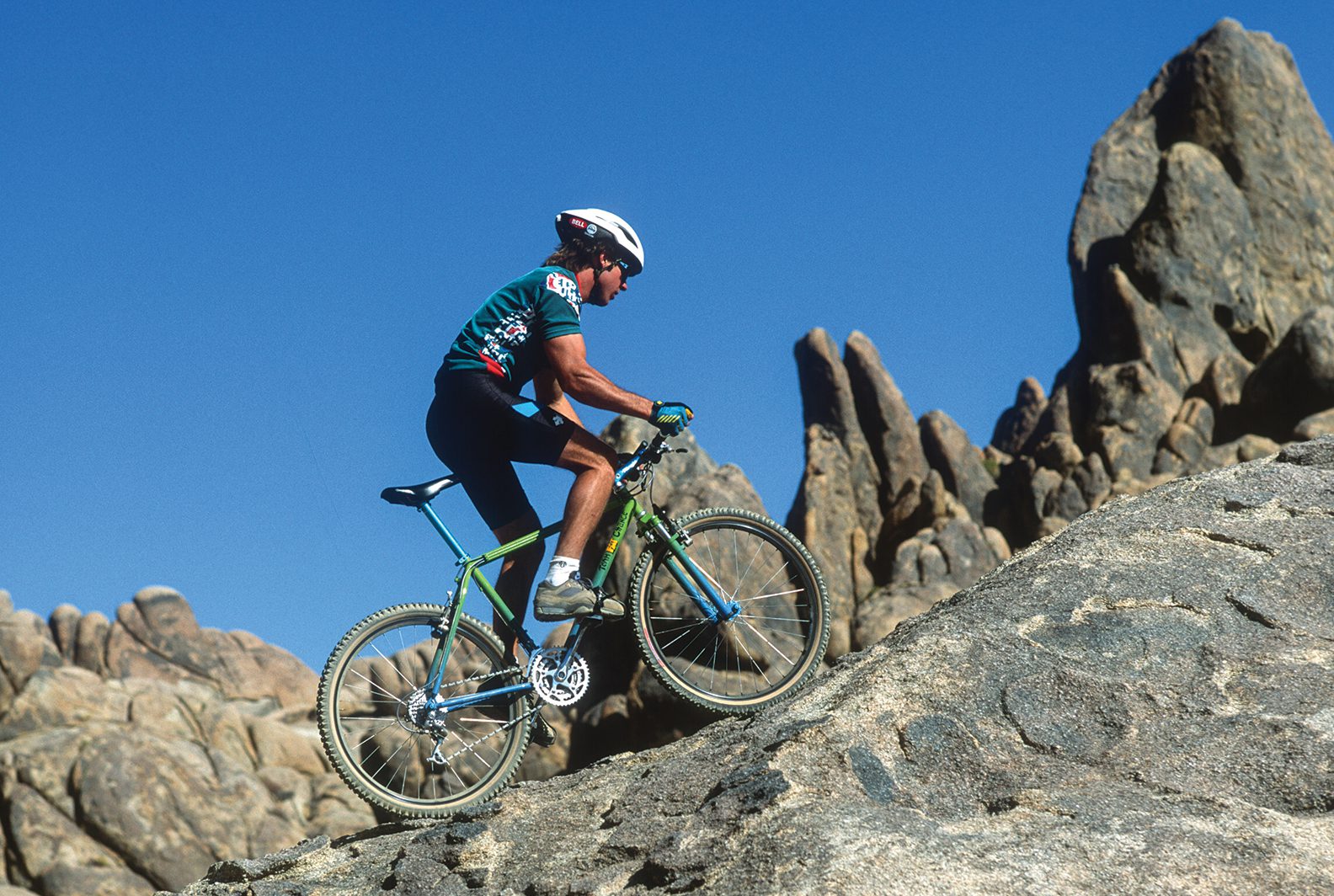
30 Apr Flashbacks From a Mountain Biking Mecca
An accomplished photographer recalls the early years of the sport in Tahoe, where capable athlete friends helped execute innovative shoots
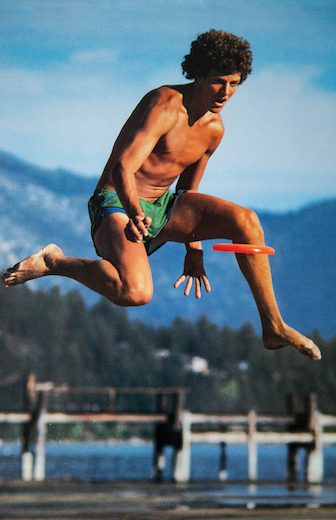
A young Larry Prosor partakes in a game of Frisbee at Moon Dune Beach in Tahoe Vista, photo by Bob Bisesto
Living within my 67-year-old body is a 20-year-old playing Frisbee with friends on a drought-stretched beach in North Lake Tahoe. It’s early spring 1977 and there’s zero snow at lake level. Between throws and catches, a faraway flash from across the lake, high above the East Shore, catches my eye. The glimmer is coming from a horizontal slash in the mountainside above Sand Harbor, known by locals as the “sand chutes.”
Hmmm, interesting. What’s a ski bum/Frisbee player/photographer with free time to do? Hunt down the source of the reflection, of course!
Leaving my friends and Frisbee game behind, I depart on a solo mission to scout the location. I park at Sand Harbor, cross the road and begin weaving my way through dense clutches of manzanita, searching for a direct ascent to the mysterious light. It’s a leg pumper, one step forward and a half-step back, as I scamper some 1,500 vertical feet in the soft sand toward the ridgeline. The sun reflects off the lake below and I’m solar cooking.
I look up and spy the flash—a shiny metal pipe, kinked and crushed, scattered among milled timber from a distant era.
The crux move to the cut is near-vertical with shifting sand, loose rock and splintered wood with rusty nail fangs looking for my foot. I clamber onto a man-made platform carved into the mountainside and relax on the level ground, surrounded by old, beaten relics of a water flume that once traversed the slope.
I turn around to face the Lake of the Sky. My jaw drops. After photographing the amazing lake view, I happily race the sunset, running down the sand chutes with Superman strides, leaping off rocks, landing in steep, forgiving sand. Back at the truck, I vow to return.
And I did—many times, every season, even winter.
In fact, I wooed my wife Cindy at this magical spot in a series of early date challenges, unaware that the scenic location we had all to ourselves would one day rank among the most iconic stretches of trail in the world. The rugged slice of mountainside would also serve as a launching point for my career as an action-sports photographer in Tahoe, which would soon become an early hotbed for the burgeoning sport of mountain biking—with plenty of skilled athletes to help push its progression.
Rise of a Nascent Sport
A big thanks to the creative and hard-working Max Jones, the mountain biking legend who—six years after my first visit to the sand chutes—cleared the remains of the historic water flume and other debris to create what we enjoy today as the Flume Trail.
My first time riding the Flume was on a heavy, steel-frame, no-shocks, narrow-tire mountain bike clunker. The Flume and Tahoe Rim trails were not official yet, and there were no rules saying where you could or couldn’t ride a mountain bike on the East Shore.
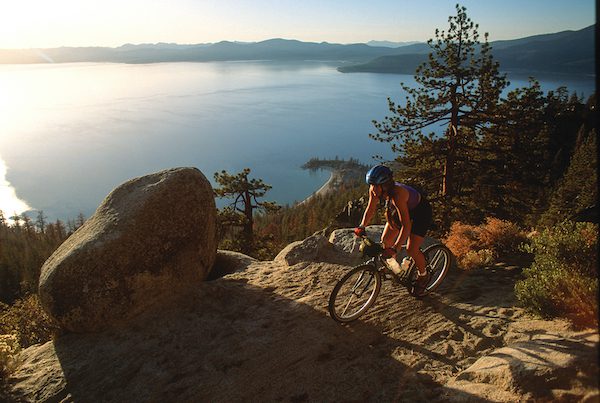
Christina Probert rides the Flume Trail above Sand Harbor, photo by Larry Prosor
Tahoe and Marin County cycling pioneers like Peter Underwood led me on many exploratory mountain bike adventures starting in the 1980s. Now co-owner of Olympic Bike Shop, Underwood pioneered many routes in the sport’s early era, most notably the famed Downieville Downhill north of Truckee.
Those shaky first backcountry bike outings were challenging and at times dangerous. Sometimes, basic foot straps made it hard to eject. With no helmets and relatively primitive gear, trouble was always lurking if you got injured, had equipment failure or got lost as night approached. There were no cell phones, rescue beacons or GPS.
One late October day, Underwood and a few friends got lost deep in the Donner Summit backcountry. I received a frantic call from a worried wife. What to do? After arriving at Olympic Bike Shop early the next morning to see if I could help with the search, Underwood showed up covered in ash, his eyes swollen from a night huddled by a fire used to stave off hyperthermia. I was glad to have bowed out on that adventure.
Capturing the Action
As time rolled on, I found myself photographing mountain biking and the evolution of the equipment—a front-row seat to the steady ascent of the sport, which we had no idea would grow to become as popular as it is today.
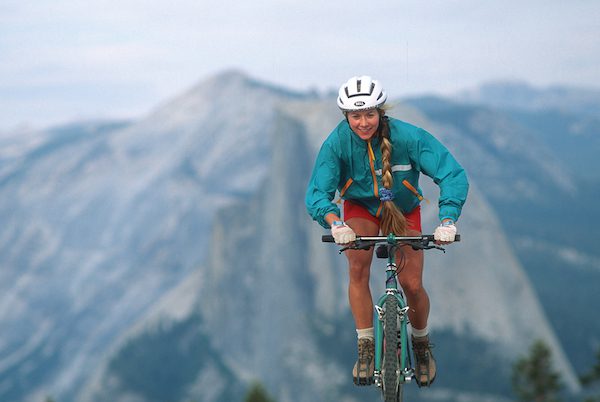
Tina Vindum rides her mountain bike with Half Dome as a backdrop, photo by Larry Prosor
I tracked down early mountain bike companies and media at the Outdoor Retailer shows in Las Vegas each year. With my photo portfolio in hand, I’d urge marketing directors to let me photograph their offerings. And it worked. I’d head back to Truckee loaded with the following year’s bike products.
The greater Tahoe area became my backyard for mountain biking photography. Skiers and boarders of the region took to the sport naturally, and I called on my athletic friends to be mountain bike “models”—talented people such as Jim and Bonnie Zellers, Gregg Betonte, Bob White, Tina Vindum, Christina Probert, Rowe Giesen, Robbie Huntoon, Cathy Taylor and Underwood, among others.
Print media responded with multiple mountain biking magazines. Tourism expanded with the help of mountain biking in ads and brochures. Recognizing the opportunity, I shot many covers for magazines such as BIKE, Mountain Bike, Snow Country and Outdoor Retailer, along with companies like Scott, Bell, Trek, Patagonia, The North Face and more.
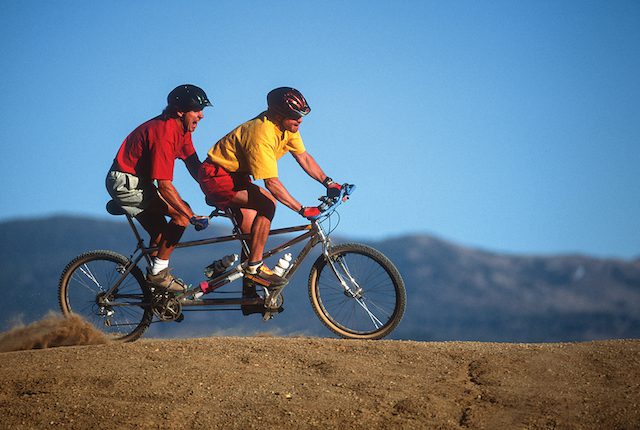
Gregg Betonte (driver) and Jim Zellers at Prosser Pits in Truckee, photo by Larry Prosor
One of the memorable covers was the debut issue of BIKE Magazine in March 1994. The photo features Gregg Betonte blasting through a cloud of dust kicked up by an unpictured Jim Zellers, who had just skidded into a turn to create the setting for the backlit shot against a Sierra sunset.
Another time I had Betonte and Zellers ride a tandem mountain bike. The two often bantered as friends, with Zellers a grounding rod to Betonte’s occasional bravado. Tandem riding between them was a test of two-seater marriage. They took turns piloting, each trying to out-scare the other back-seat test dummy. Together they launched airs and cranked turns in the late-afternoon sun at Prosser Pits—a handy photo location near my Truckee home with great sunset lighting, jumps, banked turns and plenty of dust.

Peter Underwood and friends ride through an aspen grove on Conway Summit above Bridgeport, photo by Larry Prosor
Among other prime spots to photograph Tahoe’s early mountain bikers, Donner Summit was ideal for shooting big granite slabs with riders balancing on unforgiving rock. The outskirts of town in the growing Shire of Glen—better known as Glenshire—offered fun riding on narrow trails and old dirt roads through sagebrush and pine. From there, we’d ride all the way to Martis Peak overlooking Lake Tahoe from the north, or choose the Mount Rose direction and sort out the many options. Back then, we had open range.
Expanding my locations, I began organizing bike-shooting adventures in the Sierra Foothills, Eastern Sierra, Northern Nevada, White Mountains, Death Valley, Yosemite, Point Reyes and Moab, Utah, enlisting my Tahoe friends as travel mates and models. We were mostly on the lookout for scenic backdrops. First we’d scout the spots, then discuss safety and action variables. Oftentimes we’d spend the night camping and wait until sunset and sunrise to capture the best lighting.
Of course, back then—as in now—Mother Nature had a way of humbling humans recreating in the outdoors.
One fall morning, I was solo freewheeling down the dirt road from Marlette Lake to Spooner Lake after shooting the sunrise and golden aspens. It was a familiar ride and I was carrying speed into a sweeping turn when, suddenly, the big ass of a bear appeared on a collision course with my bike! I locked it up and rode out a long skid to a dusty stop, far too close to the bear, which had swung around and was facing me with a “WTF” look.
After we shared startled stares, the bear sprinted up a steep slope like it was flat ground and disappeared into the forest, leaving me pumping with fight, flight or freeze instincts—and a big dose of adrenaline. Glancing down at our footprints in the dust, our tracks were shoe to paw.
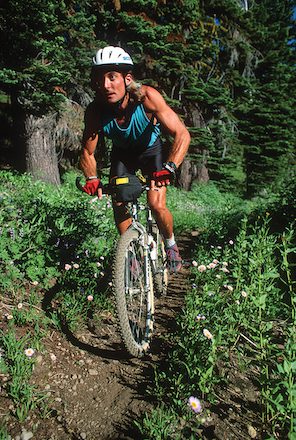
Scott Williams near Bucks Lake in Plumas County, photo by Larry Prosor
Bike to the Future
Fast-forward a few decades, and mountain biking has ventured into new territory with the emergence of e-bikes. This latest craze in biking can sometimes cause emotions to run high on the trail, as there are many examples of less-than-fit-and-experienced riders on powerful e-bikes getting Goofy-driver syndrome. It’s a reminder that, regardless of the era or advances in equipment, mountain biking is not Disneyland. It’s fun, until you hit a solid object.
Two summers ago, I found myself in the Tahoe Forest Hospital emergency room getting dirt, rocks and bone chips flushed from a deep, long gash on my forearm. It was the first time in all my years of riding a bike that I was hurt badly.
I was alone on a familiar gravel road near our family cabin at Bucks Lake in Plumas County, riding directly into the early morning sunrise. As I leaned into a turn, my back tire clipped a fist-sized rock that had rolled down the embankment, sending me sliding to a rude stop on the gravel. Ouch! I cleaned the gash in a creek and wrapped my shirt around my arm to apply pressure, limped my semi-busted bike miles back to the cabin and, after a shower resembling a scene from an Alfred Hitchcock movie, drove myself to the ER in Truckee.
Nowadays back at my home in New Zealand, where my wife and I moved from Truckee in 2004, I ride both an “acoustic” mountain bike and an e-bike, depending on the destination and company.
Far from my youth—and my treasured Schwinn Stingray with the banana seat—I’ve been lucky to grow up with the freedom to wander in the mountains on my bike. And while mountain biking has advanced significantly since the early days in the Tahoe Basin, the defining aspect of the sport remains the same: Fun! On my mountain bike, I’m a kid again, living within my 67-year-old body.
Larry Prosor is a former Tahoe-based photographer and former co-owner of Fine Line Productions. Find more of his work at larryprosor.co.nz.




No Comments